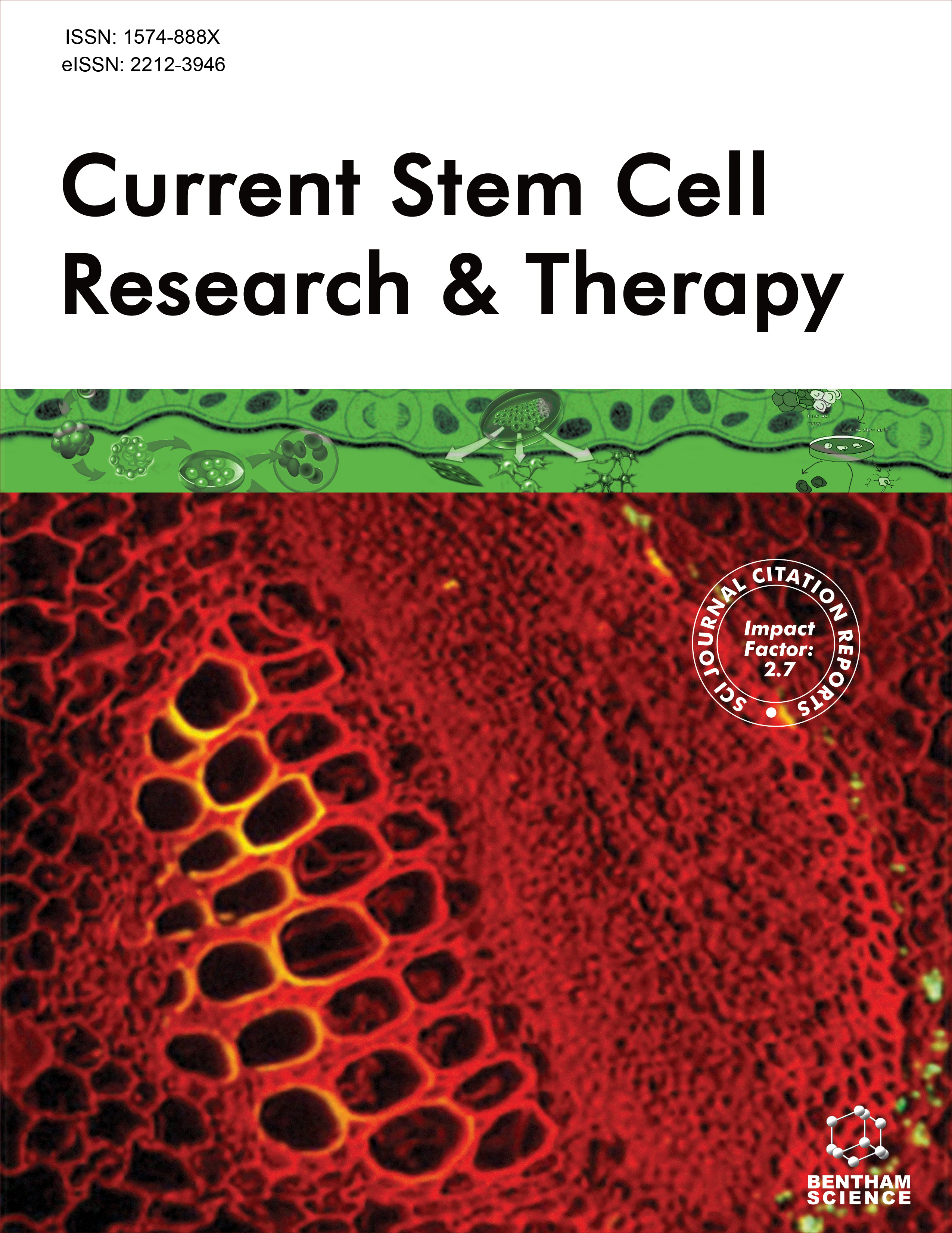- Home
- A-Z Publications
- Current Stem Cell Research & Therapy
- Previous Issues
- Volume 2, Issue 1, 2007
Current Stem Cell Research & Therapy - Volume 2, Issue 1, 2007
Volume 2, Issue 1, 2007
-
-
The Impact of New Emerging Drugs in the Treatment of Multiple Myeloma:Is there Still a Role for PBSC Transplantation?
More LessAuthors: Alessandro Corso and Marzia VarettoniHigh-dose therapy with the rescue of autologous stem cells represents today the standard approach for multiple myeloma patients aged <65 years. Several studies, in fact, have demonstrated the superiority of high-dose therapy with respect to conventional chemotherapy in younger patients. Peripheral blood stem cells (PBSCs) provide a rapid and effective hematopoietic recovery after the administration of supra max Read More
-
-
-
Neural Stem Cells as Biological Minipumps: A Faster Route to Cell Therapy for the CNS?
More LessAuthors: H. Isaac Chen, Asha Bakshi, Nicolas C. Royo, Suresh N. Magge and Deborah J. WatsonOne strategy for the use of neural stem cells (NSCs) in treating neurological disorders is as transplantable “biological minipumps”, in which genetically engineered neural stem cells serve as sources of secreted therapeutic (neuroprotective or tumoricidal) agents. Neural stem cells are highly mobile within the brain and demonstrate a tropism for various types of central nervous system (CNS) pathology, making them pro Read More
-
-
-
The Role of Stroma in Hematopoiesis and Dendritic Cell Development
More LessAuthors: Genevieve Despars, Jonathan Tan, Pravin Periasamy and Helen C. O'NeillDevelopment of the immune system is depicted as a hierarchical process of differentiation from hematopoietic stem cells (HSC) to lineage-committed precursors, which further develop into mature immune cells. In the case of dendritic cell (DC) development, this linear precursor-progeny approach has led to a confused picture of relationships between various subsets of DC identifiable in vivo. A possible reconciliati Read More
-
-
-
Telomerase Activation in Liver Regeneration and Hepatocarcinogenesis:Dr. Jekyll or Mr. Hyde?
More LessAuthors: Henning Wege and Tim H. BrummendorfThe liver has a remarkable capability to restore its functional capacity following liver injury. According to the current paradigm, differentiated and usually quiescent hepatocytes are the primary cell type responsible for liver repair. As reserve compartment, bipotent hepatic progenitor cells are activated, especially if extensive loss or damage of hepatocytes with impaired replication occurs, e.g. in cirrhotic liver tissue. Recently, a Read More
-
-
-
Function and Malfunction of Hematopoietic Stem Cells in Primary Bone Marrow Failure Syndromes
More LessAuthors: Antonio M. Risitano, Jaroslaw P. Maciejewski, Carmine Selleri and Bruno RotoliHematopoietic stem cells (HSCs) are responsible for the production of mature blood cells in bone marrow; peripheral pancytopenia is a common clinical presentation resulting from several different conditions, including hematological or extra-hematological diseases (mostly cancers) affecting the marrow function, as well as primary failure of hematopoiesis. Primary bone marrow failure syndromes are a heterogeneous group o Read More
-
-
-
Stem Cell Transplantation in Pediatric Leukemia and Myelodysplasia: State of the Art and Current Challenges
More LessAuthors: Marc Bierings, James B. Nachman and C. Michel ZwaanThe role of stem cell transplantation in the treatment of leukemia and myelodysplasia (MDS) in children has changed over the past decade. In pediatric acute lymphoblastic leukemia (ALL), the overall curerate is high with conventional chemotherapy. However, selected patients with a high-risk of relapse are often treated with allogeneic hematopoietic stem cell transplantation (allo-HSCT) in first remission (CR1). Patients wit Read More
-
-
-
High-Dose Chemotherapy Followed by Autologous Hematopoietic Stem-Cell Transplantation for the Treatment of Solid Tumors in Adults: A Critical Review
More LessAuthors: Giuseppe Luigi Banna, Matteo Simonelli and Armando SantoroHigh-dose chemotherapy (HDCT) plus autologous hematopoietic stem-cell transplantation (HSCT) has been explored in several solid tumors in the attempt to prevent and/or overcome tumor-cell chemoresistance, based on in vitro evidence of a “dose-response” effect. Preliminary encouraging results from nonrandomized trials, led to an increased use of this strategy in the 1990s. Since the end of the nineties, the fraudulent nat Read More
-
-
-
Regenerative Medicine and Liver Injury: What Role for Bone Marrow Derived Stem Cells?
More LessAuthors: Stefania Lorenzini and Pietro AndreoneIn recent years, great interest has been aroused by the discovery of the ability of adult stem cells to contribute to regeneration processes and repair of damaged tissues. In particular, bone marrow derived stem cells (BMSCs), the most well known population of multipotent stem cells in adults, have been shown to be able to generate many different committed cellular types. In this review, we systematically organize the Read More
-
-
-
Stem Cell Migration: A Quintessential Stepping Stone to Successful Therapy
More LessMigration is an innate and fundamental cellular function that enables hematopoietic stem cells (HSCs) and endothelial progenitors (EPCs) to leave the bone marrow, relocate to distant tissue, and to return to the bone marrow. An increasing number of studies demonstrate the widening scope of the therapeutic potential of both HSCs and endothelial cells. Therapeutic success however not only relies upon their ability to repair dam Read More
-
-
-
Hematopoietic Stem Cell Transplantation from Alternative Donors for High-Risk Acute Leukemia: The Haploidentical Option
More LessMuch progress has been made in the clinical, biological and technical aspects of the T-cell-depleted full-haplotype mismatched transplants for acute leukemia. Our experience demonstrates that infusing a megadose of extensively T-cell-depleted hematopoietic peripheral blood stem cells after an immunomyeloablative conditioning regimen in acute leukemia patients ensures sustained engraftment with minimal graft-vs-host diseas Read More
-
Volumes & issues
-
Volume 20 (2025)
-
Volume 19 (2024)
-
Volume 18 (2023)
-
Volume 17 (2022)
-
Volume 16 (2021)
-
Volume 15 (2020)
-
Volume 14 (2019)
-
Volume 13 (2018)
-
Volume 12 (2017)
-
Volume 11 (2016)
-
Volume 10 (2015)
-
Volume 9 (2014)
-
Volume 8 (2013)
-
Volume 7 (2012)
-
Volume 6 (2011)
-
Volume 5 (2010)
-
Volume 4 (2009)
-
Volume 3 (2008)
-
Volume 2 (2007)
-
Volume 1 (2006)
Most Read This Month
Article
content/journals/cscr
Journal
10
5
false
en


